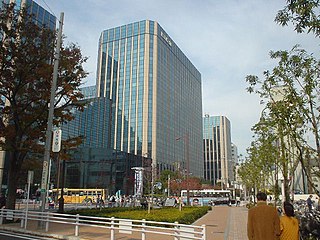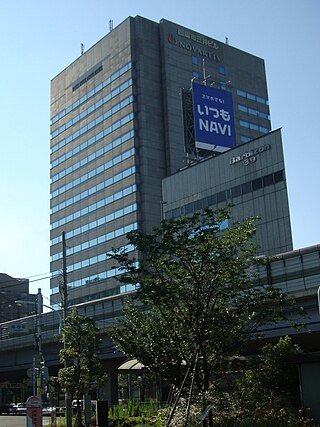

Kamata (蒲田) is a district of Ōta, Tokyo, Japan. Features include the Kamata Station, Kamata High School, and the headquarters of Toyoko Inn. [1] [2]


Kamata (蒲田) is a district of Ōta, Tokyo, Japan. Features include the Kamata Station, Kamata High School, and the headquarters of Toyoko Inn. [1] [2]
The name "Kamata" has been used to refer to the area since at least the 900s AD. Historically, the area was famous for Japanese apricots (ume).
Kamata was first linked to nearby towns of Kawasaki, Kanagawa and Ōmori, Tokyo by rail in 1901 with the opening of Kamata Station (now Keikyu Kamata Station) on the Keihin Electric Railway. This was followed in 1904 by the opening of a separate Kamata Station on the Tokaido Line providing connection to Tokyo and Yokohama.
Kamata became a ward of Tokyo City in October 1932, incorporating the historical towns of Kamata, Yaguchi, Rokugo and Haneda. Kamata merged with the neighboring ward of Omori to form the ward (city) of Ota in March 1947. [3]
Ota operates the public elementary and junior high schools in Kamata.
Kamata Elementary School (蒲田小学校) serves Kamata 1-3-chome and parts of 4 and 5-chome. Shinshuku Elementary School (新宿小学校) serves parts of 4 and 5-chome. [4]
All of Kamata (1-5 chome) is zoned to Kamata Junior High School (蒲田中学校). [5]
Tokyo Metropolitan Board of Education operates Kamata High School.

Ōta is a special ward in the Tokyo Metropolis in Japan. In English, it is often called Ōta City.

Setagaya is a special ward in the Tokyo Metropolis in Japan. It is also the name of a neighborhood and administrative district within the ward. Its official bird is the azure-winged magpie, its flower is the fringed orchid, and its tree is the Zelkova serrata.

Arakawa is a special ward in the Tokyo Metropolis in Japan. The ward takes its name from the river, the Arakawa, though the Arakawa River does not run through or touch the ward. Its neighbors are the wards of Adachi, Kita, Bunkyo, Taito and Sumida. In English, the ward calls itself Arakawa City.

Nagatachō is a district of Tokyo, Japan, located in Chiyoda Ward. It is the location of the Diet of Japan and the Prime Minister's residence (Kantei). The Supreme Court of Japan is located in neighboring Hayabusachō. Nagatachō is often used to refer to the elected Japanese government, while Kasumigaseki refers to the unelected bureaucratic administration.

Hongō (本郷) is a district of Tokyo located in Bunkyō, due north of the Tokyo Imperial Palace and west of Ueno.

Shibaura (芝浦) is a district of Minato ward located in Tokyo, Japan. The district is located between the eastern side of the Yamanote Line train and Tokyo Bay. Shibaura consists mostly of artificial islands created by the excavation of industrial canals in the early 20th century. Formerly a light industrial area, it became famous for its night life during the Japanese asset price bubble period and, since the early 2000s, has become a high-rise residential district.

Ueno (上野) is a district in Tokyo's Taitō Ward, best known as the home of Ueno Park. Ueno is also home to some of Tokyo's finest cultural sites, including the Tokyo National Museum, the National Museum of Western Art, and the National Museum of Nature and Science, as well as a major public concert hall. Many Buddhist temples are in the area, including the Bentendo temple dedicated to goddess Benzaiten, on an island in Shinobazu Pond. The Kan'ei-ji, a major temple of the Tokugawa shōguns, stood in this area, and its pagoda is now within the grounds of the Ueno Zoo. Nearby is the Ueno Tōshō-gū, a Shinto shrine dedicated to Tokugawa Ieyasu. Near the Tokyo National Museum there is The International Library of Children's Literature. Just south of the station is the Ameya-yokochō, a street market district that evolved out of an open-air black market that sprung up after World War II. Just east is the Ueno motorcycle district, with English-speaking staff available in some stores.

Hiyoshi (日吉) is a part of the city of Yokohama, Kanagawa Prefecture, Japan. It is located within Kōhoku Ward in the northeast of Yokohama City.

Nakahara-ku (中原区) is one of the 7 wards of the city of Kawasaki in Kanagawa Prefecture, Japan. As of November 2014, the ward had an estimated population of 244,565 and a density of 16,637 persons per km². The total area was 14.70 km².

Ōmori (大森) is a district located a few kilometres south of Shinagawa, Tokyo, Japan accessed by rail via the Keihin Tohoku line, or by road via Dai Ichi Keihin. Ōmorikaigan, the eastern area of Ōmori, can be reached via the Keikyu line.

Tateishi (立石) is a neighborhood in Katsushika, Tokyo, Japan. The name derives from a tiny stone monument called Tateishi-sama (立石様), located at 8-37 Tateishi. With its retro-chic shopping streets and small, back-street workshops and factories, the area retains an atmosphere associated with Tokyo's earthy Shitamachi ("downtown") neighborhoods. Katsushika Ward Office, is located at 5-13-1 Tateishi.

Shiba (芝) is an area of Minato ward in Tokyo, Japan and one of districts in the Shiba area.

Den-en-chōfu (田園調布) is a residential neighborhood located in western Ōta in southern Tokyo, Japan. It is known as one of the most exclusive neighborhoods in Tokyo.

Mita (三田) is a district of Minato, Tokyo, Japan. It was once home to grand estates of several daimyo, and now is one of Tokyo's most expensive upscale residential districts; it is home to many artists, CEOs, and celebrities.

Kanda-Surugadai is a district of Chiyoda, Tokyo, Japan. It was named after Tokugawa Ieyasu's death, when the Edo government allowed officials from Sunpu to live in the area. Kanda-Surugadai is often called Surugadai or, colloquially, Sundai.

Ogawamachi (小川町), or formally Kanda-Ogawamachi (神田小川町), is a district in Chiyoda, Tokyo, Japan. It consists of 3 chōme. As of March 1, 2007, the district's population is 875.

Kajichō (鍛冶町) is a district of Chiyoda, Tokyo, Japan. It consists of Kajichō 1-chōme and Kajichō 2-chōme. This article also explains about Kanda-Kajichō (神田鍛冶町), which today only has Kanda-Kajichō 3-chōme. As of April 1, 2007, the total population of the two districts is 371.

Hirakawachō is a district of Chiyoda, Tokyo, Japan, consisting of 1-chōme and 2-chōme. As of April 1, 2007, its population is 1,104. Note that Kanda-Hirakawachō, also located in the Chiyoda ward, is a completely different district. Hirakawachō's postal code is 102-0093.

Kudankita (九段北) is a district of Chiyoda, Tokyo, Japan, consisting of four chōme. It was a part of the former ward of Kōjimachi. As of March 1, 2007, its population is 1,404. Kudankita is a luxury and prestigious residential and business zone.

Nishi-Azabu (西麻布) is a district of Minato, Tokyo, Japan, which was a part of the former Azabu Ward.
35°33′44.92″N139°42′57.78″E / 35.5624778°N 139.7160500°E